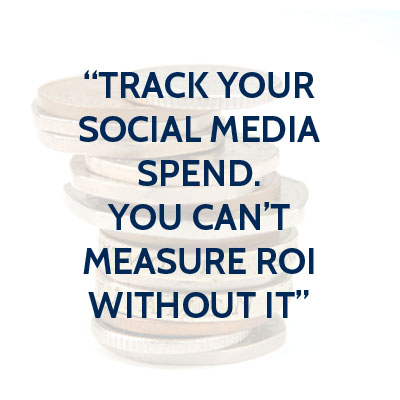
Is your business making a profit on its social media activity?
If you’re like most, you’re probably not 100% sure. And if you are convinced it’s contributing to your bottom line, you’re probably unclear about just how much.
This is terrible for your social media programme. If you can’t make the business case for it – showing that it is actually bringing you valuable new leads, enquiries and sales – it will be hard to convince your boss, your colleagues, even yourself, that it is worthwhile, and that its budget is justified.
You also need to know if it isn’t delivering the results you need, if you’re to fix it.
What you need to make the case either way is good, old-fashioned, hard data. Where do you start? Here’s your step-by-step guide to gathering all the facts and figures you need to prove what kind of Return-on-Investment you’re generating online….
Set ROI Goals
Most companies measure their success on social media by how many followers they get, how many ‘likes’ they’re generating and how often they’re retweeted. That kind of thing. It’s all really important to know in order to run a successful social media programme – but ultimately, these do not directly bring you new sales, leads and clients.
Before you start your programme, make sure that your goals are primarily ROI goals – those that will help you prove the financial worth of your programme.
ROI goals could include:
- Percentage of sales originating from social media
- Number of LinkedIn Connections converting into sales leads
- Repeat business resulting from social media
- Cost per lead compared to other channels
- Cost savings from transferring customer services online
- Cost savings from moving PR activities online
Non ROI goals might be:
- Positive Word of Mouth
- Facebook Fans
- Blog Comments
- Social Mentions
- Click Throughs
- YouTube Views
- Forward to a Friend
- Repeat visitors
- Retweets / Shares
- Advocacy
Being able to differentiate between ROI and non-ROI goals boils down to a simple question. Do the metrics prove that there were more enquiries or sales as a result of your social media campaign? You’ll find it tricky to prove this just on the basis of Facebook followers or re-tweets.
Keep track of costs
 To successfully measure ROI, it’s not enough to measure your return (the sales and leads).
To successfully measure ROI, it’s not enough to measure your return (the sales and leads).
You also need to measure the first half of the equation, the investment.
Some common expenses you need to take into account include:
- Staff: In-house, freelance and agency
- Staff training time
- Upgrading social media accounts
- Inbound marketing tool
- Email marketing platform
- Customer Relationship Management (CRM) solution
- Paid analytics tools like Social Bakers, Simply Measured, and some functions in Twitonomy and Hootsuite
- Content creation: Video, webinar platform, graphics, etc.
- Social media advertising and Pay-Per-Click
- Search Engine Optimisation
- Web design
- Legal advice
Track results online
Measure website conversions
Insert Google Analytics code on every web page where you generate leads and sales, such as pages offering lead magnets, checkout pages and enquiry forms. This will enable Google Analytics to measure every time your web visitors take a desired action, such as downloading a free resource, or visiting a certain page a set number of times. These actions are called ‘Goals’.
Based on how much leads are worth and what percentage convert into customers, you can place a value on the goals; for example if you attract 40 enquiries a month via your website enquiry form and you know that roughly 1 in 4 convert into customers and are worth an average of £1000, you can set each goal a value of £250.
Track leads from your email campaigns, webinars, advertising etc.
Use each platform’s own analytics to track the leads they generate, and evaluate their performance.
Be aware of the entire customer journey
Customers usually come into contact with you multiple times, and in multiple places, before they actually make an enquiry or buy. Sometimes the metrics alone won’t reveal social media’s role. Take this customer:
- Prospect discovers your video on YouTube
- Prospect watches other videos on your channel
- Prospect searches for you on Google and discovers your blog
- Clicks on call to action on blog and downloads e-book
- As a result of reading your ebook the lead subscribes to your email newsletter
- Lead sees the trial offer for your software on an email newsletter
- Customer signs up for the trial offer via a dedicated landing page
- Customer upgrades to a full contract.
The initial interest was triggered by YouTube, but as the user found your blog via Google search the customer wouldn’t necessarily have been listed as coming via social media.
To ensure your reporting is doing justice to your social media activity, we recommend you spend some time looking at Google’s attribution models. This is a rule, or a set of rules which will help determine to what extent social media contributed to the sale that was measured by Google Analytics.
Track ‘offline’ sales that originated online
Manage your contacts
Perhaps you’ve connected with a prospective client via LinkedIn, or they attended one of your webinars. If, some time later, they ask to meet with you in person to discuss a potential deal, the fact that the initial contact was made by social media will not necessarily be recorded unless you develop a Customer Relationship Management database.
Log the details of every lead you get, what channel they used to reach you, and whether they became a customer. Systems like www.capsulecrm.com will measure this for as little as $8 per month.

Ask customers how they heard about you
Train staff to ask new prospects how they found out about your business. It makes it easier to track how many offline enquiries originated online.
Track phone calls
Set up a bespoke phone number for website enquiries, so it’s easier to tell how many callers found you online.
Benchmark your performance
Keeping a proper record of your results is crucial to evaluating them.
Before commencing any social media campaign, note the number of leads and sales you generate from other sources. Continue updating this database on a monthly basis, together with new information on the number of leads and sales you generate online, how they’re reaching you and what they’re worth. In addition, note non-ROI metrics for each platform (eg Twitter, Facebook, LinkedIn and YouTube) and analyse how much time you spend and what your overheads are.
Benchmark how your social media performance contrasts with other marketing activity. Ensure you include all your offline marketing costs so you can make a fair comparison.
Use the figures to calculate your ROI
Congratulations! You now have enough information to make a solid assessment of whether you are generating a Return-on-Investment.
The basic formula:
Total value of digital marketing sales and leads – Investment / Investment x 100 = Return on Investment (as a %)
What problems do you encounter when measuring ROI? What steps do you take to measure it? Please share your experience in the comments!






